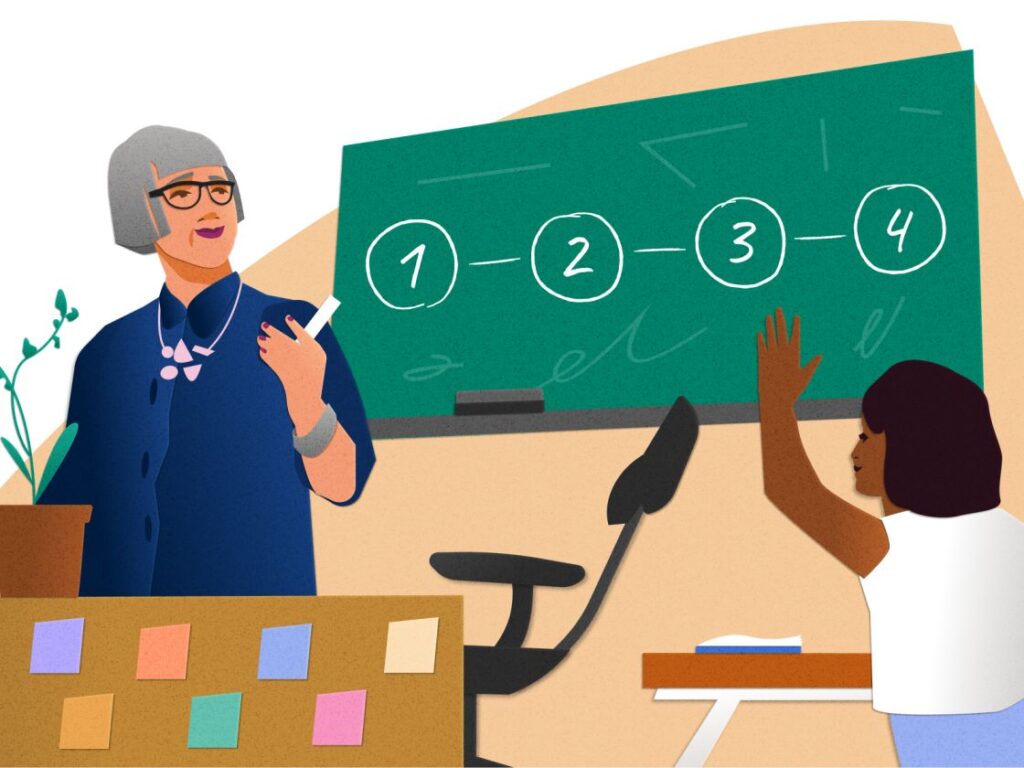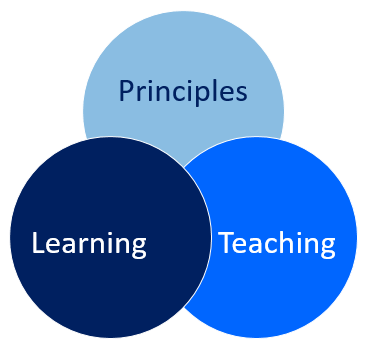PRINCIPLES OF TEACHING AND LEARNING
The principles of teaching and learning will assist the teacher to achieve purpose of teaching. It guides the teacher on the elements pertaining teaching such as whom to teach, why teach, where to teach, what to teach, how to teach and when to teach.
- Principle of motivation: The best teacher is one who inspires students. This provides an atmosphere of confidence and helps student to develop positive attitude towards the subject
- Principle of activity: Teaching should aim at having students active not passive. Teachers should set various tasks which learners should get involved in like discussion, assignment, case presentation e.t.c
- Principle of individual difference: Teaching should respect individuality of students by considering each student as unique
- Principle of selection: Teachers should select appropriate content, teaching method or aids basing on the level and needs of learners
- Principle of division: Teaching should have definite division into steps and sequenced appropriately e.g lesson of cardiac failure can be broken down into definition, types, pathophysiology, clinical feature, diagnosis and management
- Principle of correlation or association: The previous knowledge should correlate with present knowledge because our brains were not designed to recall information in isolation e.g teaching medical or surgical nursing requires knowledge of anatomy or foundations of nursing
- Principle of creativity: Teaching should allow learners to come up with new ideas or suggestions from the content taught. So the teacher should also set activities allowing room for innovation
- Principle of revision and practice: Teaching has to ensure revision or summarizing the content at the end and encourage practice of learned content periodically
- Principle of objectives: Teaching has to have well-defined objectives in order to ease content delivery and evaluation
- Principle of effect: Behaviour that leads to satisfying outcomes are likely to be repeated whereas those that lead to undesired outcomes are less likely to recur. Teaching activities should lead to the best results so that students can continue practicing them
- Principle of connection to real life: Teaching should relate the content taught to real life so that it maintains the learner’s attention span and understanding. For example, teaching in nursing has to be connected to lived experiences and that of the patient.

LESSONS LEARNED FROM THE PRINCIPLES OF TEACHING
Subject matter must possess meaning, organization, and structure.
- Meaning: Content becomes more meaningful when learners understand how the subject matter can be applied.
- Organization: Content should be divided into instructional units that clearly demonstrate the usefulness of what is being taught.
- Structure: Content must be sequenced in a way that allows learners to see and comprehend the interconnectedness of concepts.
Readiness is a prerequisite for learning.
- Educators must familiarize themselves with their learners’ interests, aspirations, aptitudes, and prior knowledge.
- Learners demonstrate their readiness for instruction.
- Instruction should be tailored to the experiences and contexts that make students willing and capable of learning. This state of readiness is highly valued by many educators.
Learners must be motivated to learn.
- The finest educators inspire students and foster their active involvement during teaching.
- Motivation to learn encompasses factors that influence learners to engage in and successfully complete learning activities.
- Motivation is influenced by personal and environmental factors.
Teaching needs to have well-defined objectives.
- Teaching activities should be based on predetermined objectives to achieve favorable outcomes.
- Learners are motivated by clearly established learning goals.
- Objectives guide the selection of content, delivery methods, and evaluation.
Success is a motivating force.
- Learners are motivated when they acquire new knowledge and skills.
- Educators should create learning activities where attainable success is achievable through proper instruction and supervision. Unrealistic standards for assessments should be avoided.
Learners are motivated when they are challenged.
- Tasks should present a level of challenge where success is attainable but not guaranteed.
- Educators must acknowledge that what is achievable for one learner might be unrealistic or uninteresting for another.
- Instructional material should cater to various difficulty levels and encompass a range of activities.
Learners must receive feedback on their learning progress.
- Feedback should encompass both strengths and weaknesses in a learner’s academic performance.
- Feedback mechanisms can be individual or group-based.
- Behaviors that are reinforced (rewarded) are more likely to be learned.
- Reinforcement should be perceived as rewarding by the learner and not solely by the educator.
Criticism should be used cautiously as research shows a negative relationship with that and academic achievement.
- Negative feedback should always be accompanied by instruction on how to correct errors.
- Reinforcement should follow the desired behavior as promptly as possible and be clearly linked to the student’s actions.
Directed learning is more effective than undirected learning.
- Directed learning involves ensuring that both educators and learners comprehend what is transpiring and why.
- Directed learning necessitates strategic instructional planning and skillful supervision.
- Learning should involve inquiry rather than strict instruction in the subject matter.
- Active learning is superior to passive learning.
Problem-oriented approaches enhance learning.
- Problem-oriented approaches ensure that all learners can actively participate in instruction.
- Revision and practice are crucial.
- Teachers must summarize content and encourage students to practice.
- Learning results from practiced actions.
- Proper technique practice with feedback is essential for success.
Content should be connected with real life.
- Retention of learning is increased when it is applied in real-life scenarios and quickly utilized after acquisition.
- Practice should closely mirror the real-life context in which behavior, skills, or attitudes are utilized.
Teaching should be correlated.
- Content must correlate with previous or related knowledge, offering learners a comprehensive understanding of the subject matter.
- Generalizations, rules, or formulas aid knowledge retention.
Individual differences should be considered.
- The teacher should recognize the uniqueness of each student and pay attention to individual differences.

QUALITIES/CHARACTERISTICS OF GOOD TEACHING
Good teaching involves the following:
Recognizes individual differences: It should consider every student as unique.
It should cause learning to take place: It allows change in behavior, i.e., they should be able to do or know something they did not know.
It involves guiding learning: It helps to develop desirable learning habits to achieve a desired aim, i.e., it should have well-defined objectives.
It provides an opportunity for activity: It should keep students as active learners but not passive.
It’s kind and sympathetic: It should make students comfortable in the presence of a teacher but not be threatened.
It should be flexible and use any teaching method to cater to learners’ different learning.
It should reduce the distance between teacher and student hence enhance teamwork.
It’s democratic: The teacher has to allow students to think and express their ideas freely but should remain in control and guide them appropriately.
It should provide desirable and selective information: The teacher should deliver information that is appropriate to the needs and level of students.
It should help the child to adjust to his/her environment: Making a child able to survive and live a productive life in society.
Consider the level of the student: Teaching should be based on the previous knowledge of the student, level of intelligence, and intellectual maturity.
It should be progressive: Teaching should enhance further development of the student to reach good positions in life.
It should be stimulating/motivating: The teacher must elicit the interest of learners with their enthusiasm for the subject, teaching method, and aid used.
It should be planned: The teacher should take prior time to plan and develop well-defined objectives. Otherwise, it implies if one fails to plan, then they plan to fail.”
It’s diagnostic and remedial: Teaching should find out educational problems of students then come up with remedial measures to address the problems.
It should be correlated: The present knowledge obtained should relate to the previous content, not distinct.

MAXIMS OF TEACHING
These are general rules of conduct to be followed by a teacher while teaching.
Proceed from known to unknown: The teacher should correlate learning with the student’s experience and previous knowledge so that the content starts from what is known and then proceeds to what is unknown.
Proceed from simple to complex: It’s also important to begin with the simplest lessons and then introduce more complex ones later. In other words, teach in increasing order of difficulty.
Proceed from overview to details: Students can easily understand if the teacher first provides an overview of the lesson and then delves into the details of the content.
Proceed from general to specific: General rules are explained first, followed by the delivery of specific information.
Proceed from specific to general: At times, it’s necessary to start with specific facts before presenting them in a general context.
Proceed from easy to more difficult: The content should be taught in increasing order of difficulty.
Proceed from concrete to abstract: Students should grasp new ideas when they are initially taught with simple illustrations (concrete aspects) before moving on to mental reasoning (abstract aspects). Therefore, start with observations and progress to intellectual reasoning.
Proceed from empirical to rational: Empirical knowledge is gained through observation and experience, while rational knowledge is based on scientific principles. Thus, it’s essential to begin with live examples and then advance to scientific reasoning.
Proceed from whole to parts: The whole holds more meaning for students compared to individual parts. Teaching the skeletal system (functions, number of bones) as a whole and later breaking down each bone’s details (e.g., femur, clavicle) allows for better correlation.
Proceed from parts to whole: In some situations, it’s beneficial to start with parts and conclude with the whole to enable students to generalize the content. For instance, teaching the advantages of rectal, oral, and sublingual routes separately before discussing the advantages of enteral routes as a whole.


Great work, Thank you so much